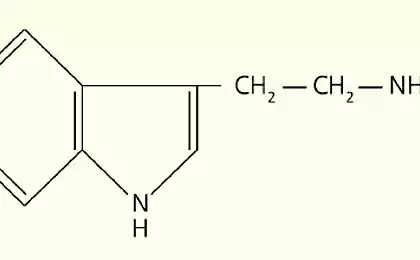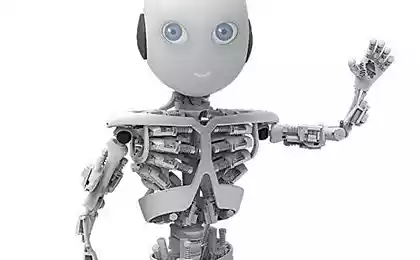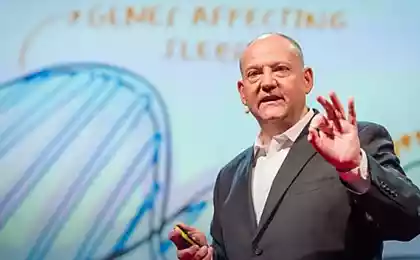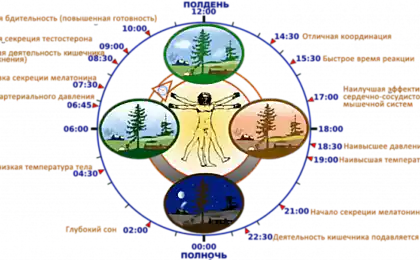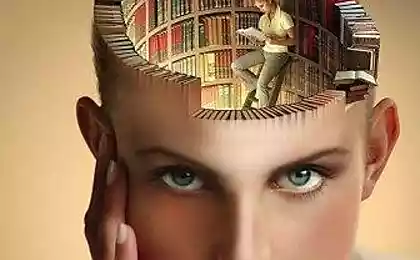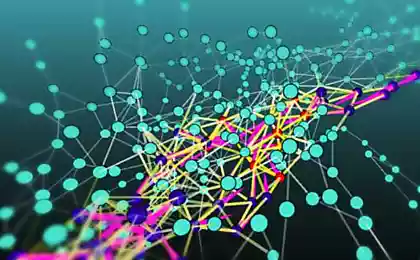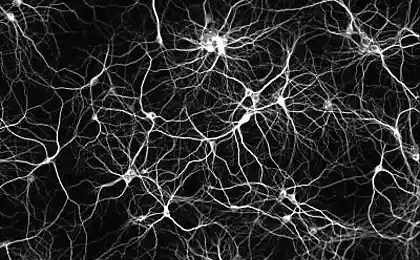474
Why we fall asleep and Wake up
Neurons that directly give the alarm to sleep or Wake up, listen to the neurotransmitter dopamine high level dopamine in the brain inhibits all sorts of sleepy signals.
Sleep and the biological clock are linked very closely, so it's easy to confuse one with the other. However, sleep is just one of the manifestations of circadian (i.e. daily) rhythm: the alternation of day and night we have hormonal changes, changes the activity of genes, and, among other things, we feel drowsiness, or, conversely, Wake up.

To go to sleep and Wake up, the body needs a team of special sleepy neurons.
It is believed that the daily alternation of sleep and wakefulness associated with the hormone melatonin: depending on the time of day its concentration either increases (in the evening) or down (to the morning), and we followed these fluctuations fall asleep and Wake up.
At the same time, it is known thatincreasing the level of melatonin does not necessarily cause sleep, rather it helps the sleep to come, working as a sedative and suppressing our reaction to the surrounding stimuli. On the other hand, everyone can sleep in the afternoon, when the biological clock to sleep are not supposed to.
Although now much is known about how the brain behaves during sleep, and how neural circuits begins to spread carotid signal, regulation of the cycle sleep–Wake is still not quite clear: metaphorically speaking, who "pulls the switch"?
It is believed that the circadian rhythm, we have the so-called sleepy homeostasis. Under homeostasis understand self-organizing system that simulates the ability of living organisms to maintain some quantities (e.g. body temperature) in a physiologically acceptable bounds.
Many are familiar with the word "homeostasis" – self-regulation, the purpose of which is to some parameters have remained constant; so, the homeostat is the direct executor of homeostasis. Homeostasis can be done in the form of an electromagnetic circuit, but in living organisms it is, of course, is made up of neurons, hormones and other molecular signals, etc.
The essence of sleep homeostat to track any figure of sleep and wakefulness: as soon as the indicator reaches a certain threshold, the device will work, and the individual is asleep. In the dream, the indicator will return to its original position, and the device will work on the revival.
Sleepy homeostasis in the brain, particular neurons that have many animals and likely to eat humans. In experiments on flies, fruit flies managed to find out that if these neurons to stimulate, then the insects fall into a sleep, and during sleep homeostat neurons remain active. During wakefulness the same neurons are "silent", and if you artificially make them insensitive to any stimuli, the fruit flies will start insomnia.
New experiments Miesenbock Gero (Gero Miesenbock) and his colleagues from Oxford, complete the picture of neurons, turns on and off sleep. Using optogenetics methods (Miesenbock, by the way, is one of the co-authors of the famous now optogenetics), they found that sleepy dopamine homeostasis is subject to control: if we stimulate in the brain of Drosophila neurons that produce dopamine, a sleepy system will remain in a waking state, its neurons are inactive. If dopamine levels fall, sleepy neurons will turn on and the fly will fall asleep; obviously, sleep continues until they work.
At the cellular-molecular level here the following happens: at the dopamine signal in the cell membrane embedded with special proteins, forming additional ion channel through which begin to "leak" ions, the concentration of the self on both sides of the membrane.
In neuronal membrane there are other ion channels that actively pumping ions inside and outside the cells, just create a potential difference, thereby making the neuron active. But with the advent of the new channel their efforts are reduced to nothing – what is happening, in a sense, compared with the short circuit in the electrical network, after which the device stops working.
A sleepy switch has only two positions, "on" and "off", what is clear – and Drosophila, and we can either sleep or not to sleep, but an intermediate state of sleep, dreaming, can't last any long. (Although, obviously, the system of the carotid homeostasis must work in cooperation with other supervisors sleep, in particular, with the same circadian rhythms.)
Louise hay: Accidents — not "cases"!
Make this mask of "Panthenol" 2 times a week and you will see what happens!
That sleepy listen of dopamine neurons signals helps to understand why many stimulants, legal and illegal, like cocaine, chased the dream , they just greatly increase the levels of this neurotransmitter in the brain. But, aside from the stimulants, then we have the next question is: how normal is switched sleepy neurons? On what parameter homeostatis neurons react before I go to sleep or Wake up?
Obviously, the dopamine there is only a "messenger", and the main signal can be either light, or loud sound (or lack of both), or General fatigue, which somehow turn into clear to a sleepy neurons command.published
Author: Cyril Stasevich
P. S. And remember, just changing your mind — together we change the world! ©
Source: www.nkj.ru/news/29310/
Sleep and the biological clock are linked very closely, so it's easy to confuse one with the other. However, sleep is just one of the manifestations of circadian (i.e. daily) rhythm: the alternation of day and night we have hormonal changes, changes the activity of genes, and, among other things, we feel drowsiness, or, conversely, Wake up.

To go to sleep and Wake up, the body needs a team of special sleepy neurons.
It is believed that the daily alternation of sleep and wakefulness associated with the hormone melatonin: depending on the time of day its concentration either increases (in the evening) or down (to the morning), and we followed these fluctuations fall asleep and Wake up.
At the same time, it is known thatincreasing the level of melatonin does not necessarily cause sleep, rather it helps the sleep to come, working as a sedative and suppressing our reaction to the surrounding stimuli. On the other hand, everyone can sleep in the afternoon, when the biological clock to sleep are not supposed to.
Although now much is known about how the brain behaves during sleep, and how neural circuits begins to spread carotid signal, regulation of the cycle sleep–Wake is still not quite clear: metaphorically speaking, who "pulls the switch"?
It is believed that the circadian rhythm, we have the so-called sleepy homeostasis. Under homeostasis understand self-organizing system that simulates the ability of living organisms to maintain some quantities (e.g. body temperature) in a physiologically acceptable bounds.
Many are familiar with the word "homeostasis" – self-regulation, the purpose of which is to some parameters have remained constant; so, the homeostat is the direct executor of homeostasis. Homeostasis can be done in the form of an electromagnetic circuit, but in living organisms it is, of course, is made up of neurons, hormones and other molecular signals, etc.
The essence of sleep homeostat to track any figure of sleep and wakefulness: as soon as the indicator reaches a certain threshold, the device will work, and the individual is asleep. In the dream, the indicator will return to its original position, and the device will work on the revival.
Sleepy homeostasis in the brain, particular neurons that have many animals and likely to eat humans. In experiments on flies, fruit flies managed to find out that if these neurons to stimulate, then the insects fall into a sleep, and during sleep homeostat neurons remain active. During wakefulness the same neurons are "silent", and if you artificially make them insensitive to any stimuli, the fruit flies will start insomnia.
New experiments Miesenbock Gero (Gero Miesenbock) and his colleagues from Oxford, complete the picture of neurons, turns on and off sleep. Using optogenetics methods (Miesenbock, by the way, is one of the co-authors of the famous now optogenetics), they found that sleepy dopamine homeostasis is subject to control: if we stimulate in the brain of Drosophila neurons that produce dopamine, a sleepy system will remain in a waking state, its neurons are inactive. If dopamine levels fall, sleepy neurons will turn on and the fly will fall asleep; obviously, sleep continues until they work.
At the cellular-molecular level here the following happens: at the dopamine signal in the cell membrane embedded with special proteins, forming additional ion channel through which begin to "leak" ions, the concentration of the self on both sides of the membrane.
In neuronal membrane there are other ion channels that actively pumping ions inside and outside the cells, just create a potential difference, thereby making the neuron active. But with the advent of the new channel their efforts are reduced to nothing – what is happening, in a sense, compared with the short circuit in the electrical network, after which the device stops working.
A sleepy switch has only two positions, "on" and "off", what is clear – and Drosophila, and we can either sleep or not to sleep, but an intermediate state of sleep, dreaming, can't last any long. (Although, obviously, the system of the carotid homeostasis must work in cooperation with other supervisors sleep, in particular, with the same circadian rhythms.)
Louise hay: Accidents — not "cases"!
Make this mask of "Panthenol" 2 times a week and you will see what happens!
That sleepy listen of dopamine neurons signals helps to understand why many stimulants, legal and illegal, like cocaine, chased the dream , they just greatly increase the levels of this neurotransmitter in the brain. But, aside from the stimulants, then we have the next question is: how normal is switched sleepy neurons? On what parameter homeostatis neurons react before I go to sleep or Wake up?
Obviously, the dopamine there is only a "messenger", and the main signal can be either light, or loud sound (or lack of both), or General fatigue, which somehow turn into clear to a sleepy neurons command.published
Author: Cyril Stasevich
P. S. And remember, just changing your mind — together we change the world! ©
Source: www.nkj.ru/news/29310/
